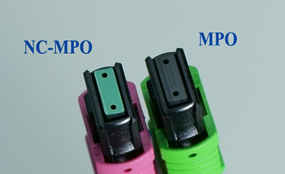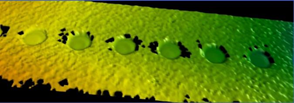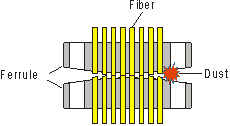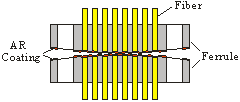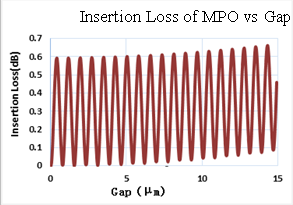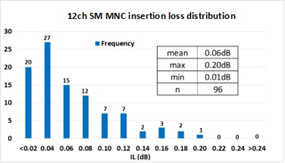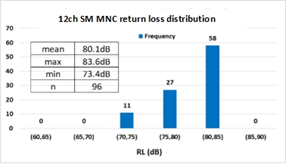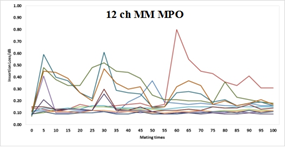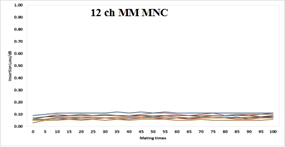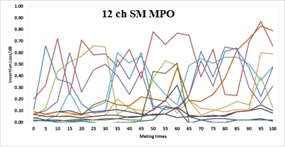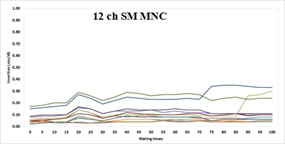Features
Why Non-Contact Fiber Optical Connector?
Non-Contact or MNC technology represents a remarkable innovation, addressing the numerous challenges that have plagued us for the past four decades. These challenges include issues like fiber end-face scratch, sensitivity to dust, breakage, connector waste, short matting life, and many more. MNC (Non-contact) connectors have been honored with the prestigious Best Innovation Award and have secured patents in both the United States and China.
Introduction to Contactless MPO Fiber Connector (MNC™)
1.1 Non-Contact Optical Fiber Connector (MNC™)
Fiber optic communication networks play a crucial role in today's information society. To accommodate the vast number of fiber optic connections, high-density multifiber connectors are necessary. These connectors can support various numbers of fibers, ranging from 8 to potentially thousands in the future.
However, the current operating principle of high-density fiber connectors poses a significant challenge as it relies on physical contact between the fiber ends to transmit optical signals. This becomes especially difficult when dealing with a large number of fibers, such as 48, where ensuring that each pair's ends touch becomes nearly impossible.
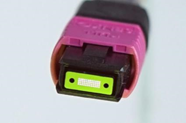
Figure 1. 48-channel Contactless MPO Fiber Connector (MNC™)
To address this issue, we have developed a non-contact MPO fiber connector that enables the transmission of optical signals without requiring physical contact between the fiber end faces. This innovative solution effectively solves this major technical problem. Figure 1 showcases our non-contact MPO fiber optic connector with 48 channels, which is trademarked as MNC™ Fiber Connector.
The MNC™ Fiber Connector builds upon the existing MPO Fiber Connector and introduces two key elements. Firstly, an anti-reflective coating on the fiber end face (Figure 2) prevents multiple reflections of light. Secondly, all fiber end faces are slightly dented compared to the plastic core surface of the connector (Figure 3). This design ensures that glass fiber end faces remain undamaged even during impact.
|
|
Figure 2. Non-contact MPO Fiber Connector (MNC™) coated with anti-reflection film (left), conventional MPO fiber connector (right) | Figure 3. The end faces of all MNC™ fiber connectors are more concave than the plastic core surfaces. Typical depressions are 1 to several microns deep. |
1.2 Comparison of the Working principles of Optical Fiber connectors
Conventional MPO connectors require that all optical fiber ends be physically connected at the same time. In general, because not all of the fiber ends are flat after polishing, tiny gaps will naturally form between the fiber ends when the MPO fiber connectors are paired. Dust and other pollutants between fiber end faces can also create air gaps. A diagram of a conventional MPO with a gap is shown in Figure 4(A).
Light is 4% reflected at the fiber/air interface. When there is a gap between the end faces of the fiber, the light is reflected several times at both ends of the fiber to form a Fabry-Perot cavity, as shown in Figure 4(b). Figure 4(c) shows the theoretical calculation of the connector insertion loss as a function of the gap. It is unacceptable that the insertion loss value oscillates rapidly with the change of the gap, which seriously affects the stability of the signal. Therefore, MPO connectors must ensure that the optical fiber ends are always in close physical contact. Otherwise, serious problems may occur.
|
|
Figure 4 (a) Schematic diagram of connecting MPO connectors | Figure 5 (a) Diagram of MNC™ connector docking |
Figure 4 (b) MPO connectors with reflections |
Figure 5 (b) MNC™ connector with no reflection |
| 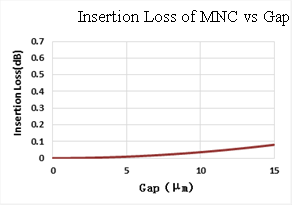 |
FIG. 4 (c) MPO insertion loss oscillates rapidly with clearance changes | Figure 5 (c) MNC™ insertion loss is almost constant with clearance changes |
The MPO fiber connector must eliminate the small air gaps that naturally exist in order to achieve physical contact. To ensure that there are no gaps, first, all fiber ends need to significantly bulge out of the ground plastic core surface. Then a large working pressure exerted by a spring needs to be applied to the MPO fiber connector, so the fiber surface is sufficiently deformed to allow multiple fibers to physically touch at the same time.
A large amount of pollutants, such as dust, exist in the actual working environment. As a result, the physical contact between optical fibers stops, and the connection stability of the optical fiber connector is poor. In a contact type MPO fiber connector, the more fibers there are, the less stable the fiber connection is.
The working pressure applied to the contact MPO fiber connector is proportional to the number of fibers. The more optical fibers, the greater the working pressure. The 48-channel MPO requires high working pressure.
Therefore, how contact MPO fiber connectors work is a big problem.
Compared to the physical contact MPO fiber connector, our MNC™ fiber connector face is lower than the plastic core surface, and the depth of the surface and fiber sag is controlled to approximately 0.6μm. The dented fiber end ensures that the connector is not damaged when matched. The anti-reflection coating layer is deposited on all fiber end faces, and after the connectors are matched, a 1.2μm air gap is created between the fiber end faces, as shown in Figure 5(a).
An anti-reflective film prevents multiple reflections of light from forming a Fabry-Perot cavity, as shown in Figure 5(b).
Figure 5(c) shows a theoretical calculation of the effect of MNC™ connector insertion losses on air clearance. When the gap increases, the insertion loss is stable and almost zero. For example, suppose the gap produced by uneven grinding is 0.5 microns, the initial gap is 1.2 microns, and the final gap is 1.7 microns. As can be seen from Figure 5(c), the insertion loss caused by the gap changing from 1.2 to 1.7 microns is negligible.
As a result, the signal transmission of the MNC™ connector is not affected by the inevitable small gaps between the end faces of the fiber, making it the ideal high-density fiber connector. MNC™ connectors work on both single-mode and multi-mode fibers.
Since there is no physical contact between the fibers, only a small spring pressure is required. Contact can be formed between the surfaces of plastic rings. The springs we use in the 24 channel and 48 channel MNC™ fiber optic connectors are the 10N springs we use in the 12 channel MNC™. MNC™ connectors do not require protruding fiber end faces, which greatly simplifies the grinding process.
1.3 MNC™ 连接器测试结果
Figure. 6(a) Insertion loss distribution of 12-channel single-mode MNC™ |
Figure. 6(b) Loss distribution of 12-channel single-mode MNC™ |
Figures 6(a) and 6(b) show the test results of insertion loss and return loss. The connector is a 12-channel single-mode MNC™ fiber connector. Insertion loss is slightly lower (better) than regular MPOs, and MNC™ return loss is approximately 10 dB higher than regular MPOs. This further validates how MNC™ works, with insertion losses not significantly increased as the beam travels in the gap between the end faces of the fiber.
Figure 7 is a direct comparison of the repeatability of insertion losses for the MPO and MNC™ connectors. The four MPO connectors (SM MPO, MM MPO, SM MNC™, MM MNC™) are paired 100 times without cleaning in between and measured every 5 times after pairing.
(a) MM MPO |
(b) MM MNC™ |
(c) SM MPO |
(d) SM MNC™ |
Figure 7. Damage of the MPO optical connector after 100 connections
Comparing the test results of the multimode MNC™ (Figure 7(a) and Figure 7(b)), we can see that the insertion loss test results of the physical contact multimode MPO are highly unstable. The MNC™ insertion loss test results are very stable. The results of the single-mode MPO and MNC™ test were compared, and the results were the same as in Figures 7(c) and 7(d).
We can also see that MNC™ has a definite advantage over traditional MPOs in terms of repeatability. Stable fiber connection reliability is the most fundamental reason why our MNC™ Fiber connector has been actively adopted by our customers.
1.4 MNC™ Fiber Connector offers superior benefits
The MNC™ Fiber Connector uses the same components and is innovative in how it works, making it a high-density fiber connector that is more reliable than regular MPOs. Many of its advantages come from its more reasonable and simple working principle.
· Low insertion loss: average 0.06dB;
· High recovery loss: 75dB (single mode);
· Repeatability of insertion damage: <0.01dB;
· Long connector life: >2,000 times (10 times MPO);
· Interchangeability: guarantee the connection between any pair of connectors;
· Not sensitive to dust;
· Low spring force: 48 channel MNC™ only needs 10N;
· MNC™ interconnects with MPO;
· MNC does not damage the device under test;
· Slightly higher cost than traditional MPO connectors.




